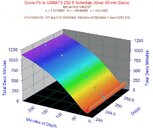- Messages
- 7,659
- Reaction score
- 4,720
- # of dives
- 200 - 499
It is most unfortunate that an extremely intellectually interesting thread degenerated into a time-suck for the mods and it got shelved as such. Much has been lost for those following this thread when the experts in the field were halted.
Maybe we can all find common ground and restricted language so the gunfight at the "I'll be OK" corral can continue.
I'd like to draw a line in the sand for both sides of the struggle. Start at the simplest profile possible that is relevant to the discussion. No accelerated deco yet. How about just attending to a rank basic "big" dive. 250 feet. On air. Bottom time as long as you like but more than 60 min. US Navy Table 5. I did substantial homework on this. Why? I'll never dive anything that constitutes a big dive, but I want to know where the gremlins are. For me, scientific curiosity and advancement of the "art". Discovering what the experts know is also most interesting. Many gems were offered in this now locked thread, I would very much like it to continue. Bubble methods should show their effects (indirectly) through their shortened deco times. How much shorter and where do they start to prevail? Graphs please.
So let's try to make it better.
Attached are the USN Air Table 5 in its entirety, a snippet of that table (250 feet schedules for deco over one hour) that was curve fit and contains a calculator for depths and times all around that limited region, and a graph of the curve fit. Nothing is locked or protected. Anyone can inspect or alter anything in the workbooks. The range was limited to allow for a really good fit to the USN Air Tables total deco time. We have something to compare to. You can find the fitting equation in the workbook.
Could all previous points be made and defended by running profiles at various conservatisms etc on only 250 foot dives? I think so.
Comparison graphs consisting of only Depth, Bottom Time, and Total Deco Time would be insanely interesting.
Mods, feel free to delete without comment if this thread is over the line...
Maybe we can all find common ground and restricted language so the gunfight at the "I'll be OK" corral can continue.
I'd like to draw a line in the sand for both sides of the struggle. Start at the simplest profile possible that is relevant to the discussion. No accelerated deco yet. How about just attending to a rank basic "big" dive. 250 feet. On air. Bottom time as long as you like but more than 60 min. US Navy Table 5. I did substantial homework on this. Why? I'll never dive anything that constitutes a big dive, but I want to know where the gremlins are. For me, scientific curiosity and advancement of the "art". Discovering what the experts know is also most interesting. Many gems were offered in this now locked thread, I would very much like it to continue. Bubble methods should show their effects (indirectly) through their shortened deco times. How much shorter and where do they start to prevail? Graphs please.
So let's try to make it better.
Attached are the USN Air Table 5 in its entirety, a snippet of that table (250 feet schedules for deco over one hour) that was curve fit and contains a calculator for depths and times all around that limited region, and a graph of the curve fit. Nothing is locked or protected. Anyone can inspect or alter anything in the workbooks. The range was limited to allow for a really good fit to the USN Air Tables total deco time. We have something to compare to. You can find the fitting equation in the workbook.
Could all previous points be made and defended by running profiles at various conservatisms etc on only 250 foot dives? I think so.
Comparison graphs consisting of only Depth, Bottom Time, and Total Deco Time would be insanely interesting.
Mods, feel free to delete without comment if this thread is over the line...





